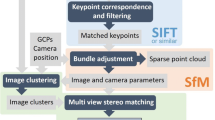Abstract
A new cloud detection algorithm for nighttime Advanced Very High Resolution Radiometer (AVHRR) data has been developed and applied to a large number of images from various locations around Japan. The algorithm is characterized by a recovery function and the use of a two-dimensional histogram. Results obtained after applying the algorithm are presented and compared with those of previous algorithms. The comparison reveals that the new algorithm appears to be more successful than the previous algorithms.
Similar content being viewed by others
References
Abe, T. (1988): A cloud detection algorithm for NOAA/AVHRR data. Master's Thesis, Tokai University, 318 pp. (in Japanese).
Duggin, M. J. and R. W. Saunders (1984): Problems encountered in remote sensing of land and ocean surface features. p. 241–287. InSatellite Sensing of a Cloudy Atmosphere ed. by A. Henderson-Sellers, Taylor & Francis, London and Philadelphia.
Flament, P., L. Armi and L. Washburn (1985): The evolving structure of an upwelling filament.J. Geophys. Res.,90, 11,765–11,778.
Gallaudet, T. C. and J. J. Simpson (1991): Automated cloud screening of AVHRR imagery using split-and-merge clustering.Remote Sens. Environ.,38, 77–121.
Huh, O. K. (1982): Satellite observations and the annual cycle of surface circulation in the Yellow Sea, East China Sea and Korea Strait.La mer,20, 210–222.
Ishii, H., Y. Michida and A. Kosugi (1984): Kuroshio Expedition and Utilization Research Project Rep. No. 7, 73–90 (in Japanese).
Kawai, H. (1972): Hydrography of the Kuroshio Extension. p. 235–352. InKuroshio: Its Physical Aspects, ed. by H. Stommel and K. Yoshida, University of Tokyo Press.
Kelly, K. A. (1985a): The influence of winds and topography on the sea surface temperature patterns over the northern California slope.J. Geophys. Res.,90, 11,783–11,798.
Kelly, K. A. (1985b): Separating clouds from ocean in infrared images.Remote Sens. Environ.,17, 67–83.
Kubota, M. (1990): Variability of the Polar Front in the Japan Sea.Sora to Umi,12, 35–44 (in Japanese).
McClain, E. P., W. G. Pichel and C. C. Walton (1985): Comparative performance of AVHRR-based multichannel sea surface temperatures.J. Geophys. Res.,90, 11,587–11,601.
Qiu, B., T. Toda and N. Imasato (1990): On Kuroshio front fluctuations in the East China Sea using satellite and in situ observational data.J. Geophys. Res.,95, 18,191–18,204.
Saunders, R. W. and K. T. Kriebel (1988a): An improved method for detecting clear sky and cloudy radiances from AVHRR data.Int. J. Remote Sensing,9, 123–150.
Saunders, R. W. and K. T. Kriebel (1988b): Errata (re: An improved method for detecting clear sky and cloudy radiances from AVHRR data).Int. J. Remote Sensing,9, 1393–1394.
Author information
Authors and Affiliations
Rights and permissions
About this article
Cite this article
Kubota, M. A new cloud detection algorithm for nighttime AVHRR/HRPT data. J Oceanogr 50, 31–41 (1994). https://doi.org/10.1007/BF02233854
Received:
Revised:
Accepted:
Issue Date:
DOI: https://doi.org/10.1007/BF02233854




